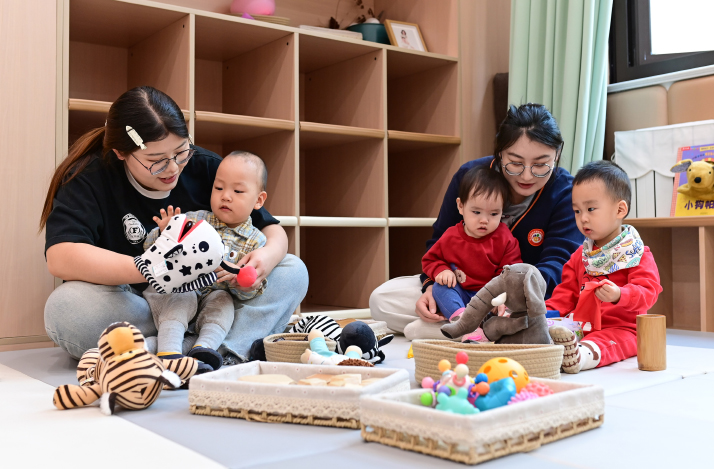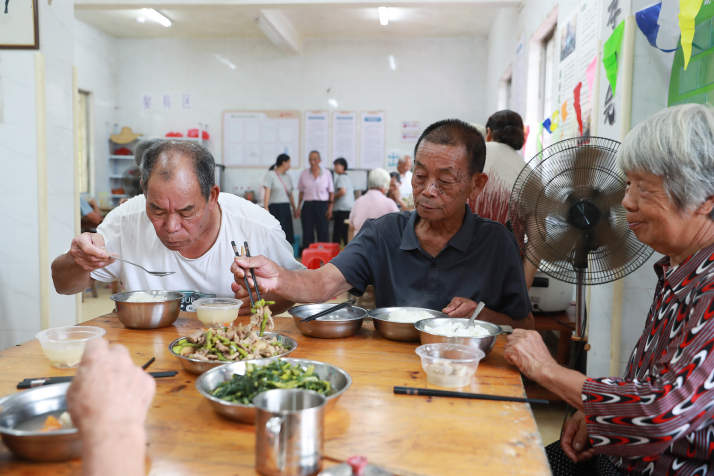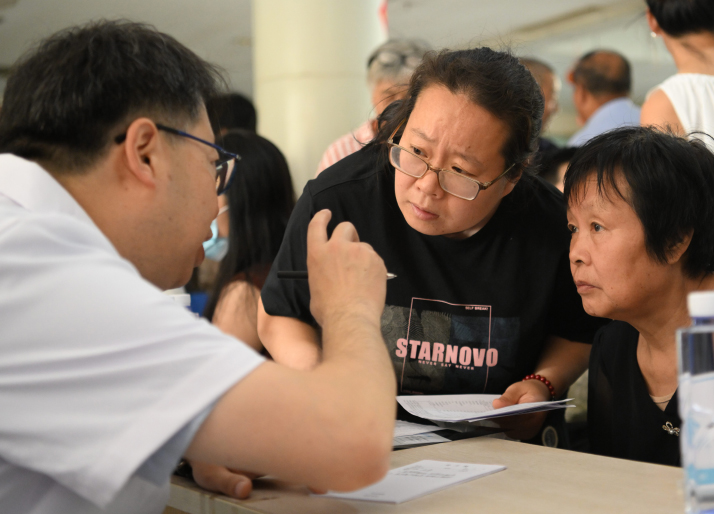| China |
| New guidelines and increased funding to improve livelihoods and achieve common prosperity | |
|
|
 Teachers play with children at a daycare center for children aged 6 months to 3 years old in Ordos City, Inner Mongolia Autonomous Region, on March 19 (XINHUA)
Every day at 8 a.m. sharp, Yu Zhengping, a resident of Shanghai's Jing'an District, takes her 2-year-old grandson to the community childcare center near her home, picking him up again at noon. The 80-plus-square-meter center has cribs, an ocean-themed ball pool and a dedicated crawling area for toddlers. Currently, every subdistrict in Jing'an has a similar childcare facility. This childcare service operates with government funding support. The Jing'an District Finance Bureau provides dedicated funding to these centers and contracts third-party organizations to manage operations. Each local child receives 12 free sessions per year, with additional sessions available at subsidized rates. Expanding the availability of publicly funded childcare slots, including actively developing community childcare centers and supporting qualified kindergartens in extending their services to children aged 6 months to 3 years old, are among the policies and measures outlined in recent guidelines on further improving people's wellbeing and addressing their most pressing concerns. The guidelines were unveiled in early June by the General Office of the Communist Party of China Central Committee and the General Office of the State Council, the highest state administrative organ. While China has achieved remarkable progress in enhancing people's living standards, including lifting nearly 100 million rural residents out of extreme poverty and establishing the world's largest social security system, further efforts are needed to address imbalances and gaps in public service delivery. Xiao Weiming, Deputy Secretary General of the National Development and Reform Commission, emphasized this at a press conference on June 10. Xiao highlighted the necessity for continued progress as the country pursues Chinese modernization, ensuring that the benefits of development are distributed more equitably among all people. "Addressing the challenges presented by an aging population, declining birth rates and diversifying employment patterns also requires us to make public services more accessible and inclusive," he stated.  Senior citizens enjoy a meal at a canteen for the elderly in Xinxi Village, Guangzhou, Guangdong Province, on June 11 (XINHUA)
Balancing development Mo Rong, President of the Chinese Academy of Labor and Social Security, told Cppcc.gov.cn, the official website of the Chinese People's Political Consultative Conference National Committee, the country's political advisory body, that the guidelines are of great importance for improving people's livelihoods and social development. They will contribute to building a new model of integrated urban-rural development, addressing developmental imbalances through reform and solidifying the social foundation for high-quality development. "For instance, with 'effectively expanding social security coverage' at the core, the guidelines comprehensively removed household registration restrictions (hukou) for flexible workers, migrant workers and those in new forms of employment to participate in social insurance at their place of employment. This promotes a shift in social security from being based on household registration to being based on permanent residence," Mo stated. New forms of employment are emerging employment patterns, including ride-hailing and food delivery, that have arisen with the development of new economic forms such as the digital economy, the platform economy and the low-altitude economy (airborne economic activities conducted below 1,000 meters). "This allows migrant workers to have equal access to public services," he added. To address the uneven distribution of high-quality resources like education and healthcare, the guidelines propose a basic education expansion and quality improvement action plan. This plan mandates the standardization of compulsory education schools within five years and the construction or expansion of 1,000 high-quality high schools. Simultaneously, the document promotes the distribution of urban medical resources to counties and the establishment of remote medical service networks. The goal is to reduce the gap in essential public services, enabling rural residents to enjoy services of the same level as their urban counterparts and fostering balanced urban-rural development. Mo further noted that the goals, such as ensuring "the proportion of nursing beds in newly built senior care facilities should, in principle, be no less than 80 percent" and ensuring "childcare services should be available in more than 80 percent of communities in large cities over the next 10 years or so," aim not only to alleviate family concerns but also inject new impetus into economic growth by increasing labor market participation.  Patients consult a medical expert at a free medical consultation event in Xinhe County, Xingtai, Hebei Province, on June 12. Organized by the National Health Commission, this event brought together experts from Beijing's top hospitals to offer free health consultations and preliminary screenings—delivering high-quality medical services directly to the community (XINHUA)
Striving for common prosperity The report to the 20th National Congress of the Communist Party of China in 2022 stated that "achieving common prosperity is a defining feature of socialism with Chinese characteristics and involves a long historical process." Mo said the recent guidelines are designed to establish an equitable, balanced, inclusive and accessible livelihood security system, aligning with the goal of achieving common prosperity. They aim to narrow the income gap and solidify the institutional foundation for common prosperity through the redistribution function of social security and the equalization of public services. For instance, in terms of support for low-income groups, the guidelines pledge to accurately identify individuals in difficulty and promptly include them in the social assistance system through a combination of big data analysis and on-the-ground investigation. The minimum living allowance, a social welfare program providing financial aid to low-income urban and rural residents, will be adjusted, linked to the per-capita consumption expenditure of urban and rural residents, ensuring that the allowance standards better reflect actual needs and safeguard the basic lives of those in need. The mechanism for adjusting minimum wage standards, which vary by provincial-level region, with tiered systems mirroring local economic conditions, will be improved, and the minimum wage itself increased, providing stronger income security for low-income workers. "These measures give low-income groups the opportunity to increase their wages, gradually narrowing the income gap," Mo said. "Promoting the provision of basic public services based on place of permanent residence is another key measure of the guidelines to promote balanced development," Mo stated. Despite China's rapid urbanization, some permanent residents still face unequal access to local public services because their hukou remains tied to their hometowns. The local benefits granted for their residence permit are far more limited than those that come with an urban hukou. The establishment of a system providing basic public services based on place of permanent residence will enable eligible rural migrants to access the same services as hukou-holders in their new urban communities. This breaks the link between hukou and access to public services, creating a more equitable and balanced social environment for common prosperity, Mo added. "In addition, promoting the adaptation of urban and rural public spaces for children, seniors and people with disabilities, and improving policies of social insurance, social welfare and taxation to back family development, will give all types of demographic groups access to social services, allowing everyone to enjoy the benefits brought by social development," he said. Intensive implementation Putting the guidelines into practice requires supporting measures, financial guarantees and the concerted efforts of governments at all levels. To ensure the effective rollout of these measures, China has pledged substantial increases in fiscal spending. Ge Zhihao, an official with the Ministry of Finance, stated at the June 10 press conference that the 2025 budget allocations for education, as well as social security and employment, will each approach 4.5 trillion yuan ($626 billion), year-on-year increases of 6.1 percent and 5.9 percent, respectively. He added that healthcare spending will also see noteworthy increases. Furthermore, central budget investment in social programs is set to rise by over 30 percent this year compared with the end of the 13th Five-Year Plan (2016-20) period, according to Xiao. Liu Cheng, a researcher with the National Academy of Economic Strategy of the Chinese Academy of Social Sciences, explained in Chinese Social Sciences Today newspaper that successful livelihood policies must balance two key approaches. First, for general public services like medical insurance and pensions, the focus should be on making these policies truly inclusive by reducing bureaucratic hurdles. This means cutting unnecessary paperwork, streamlining application procedures and making sure that support funds flow directly from financial departments to beneficiaries with minimal red tape. However, when it comes to supporting vulnerable groups like low-income households, a different approach is needed. Here, precision targeting becomes paramount. Local communities, village committees and government agencies at all levels should take proactive steps to identify those most in need through door-to-door verification and personalized outreach. This hands-on approach ensures social safety assistance reaches the people who need it most. Copyedited by Elsbeth van Paridon Comments to jijing@cicgamericas.com |
|
||||||||||||||||||||||||||||
|